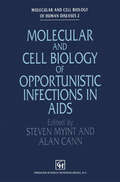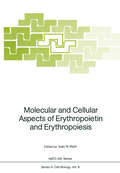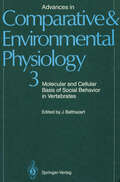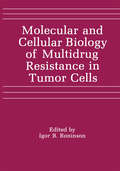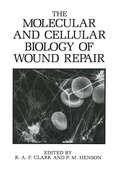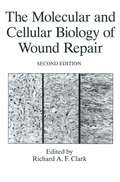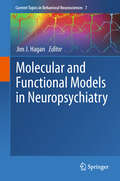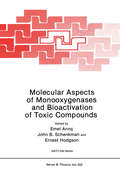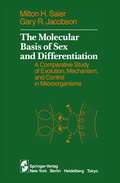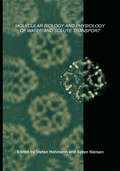- Table View
- List View
Molecular and Cell Biology of Muscular Dystrophy (Molecular and Cell Biology of Human Diseases Series)
by T. PartridgeMolecular and Cell Biology of Muscular Dystrophy gives a series of accounts of various aspects of the remarkable breakthrough which has been achieved in our understanding of the Duchenne/Becker muscular dystrophies and of the consequences and ramifications of this breakthrough.
Molecular and Cell Biology of Neuropsychiatric Diseases (Molecular and Cell Biology of Human Diseases Series)
by F. Owen R. ItzhakiMolecular and Cell Biology of Opportunistic Infections in AIDS (Molecular and Cell Biology of Human Diseases Series)
by S. Myint A. CannHuman immunodeficiency virus and AIDS have received much attention in the last decade. As the major cause of death in young adults, this concern is merited. AIDS has also ushered onto the clinical agenda a number of unusual and interesting pathogens. These have had considerably less attention than the virus itself, but are arguably as important. This book attempts to put into one volume a state of the art review of the basic biology of these opportunistic organisms. When compiling this book, the perceived difficulty was deciding how to restrict the number of chapters, as there is a large number of opportunistic organisms. It soon became clear, however, that the chapters would select themselves, as the work on many of these organisms was still in its infancy. We can be criticized for including Salmonella, which is not thought to be an opportunistic infection, and excluding Cryptococcus. Our defence is that the former has an interesting relationship with HIV and the latter is one of those organisms for which the basic biology is still in its early stages. The authors are all active researchers in their respective fields and we are grateful that they managed to review their subjects in the short turn-around time required for a book such as this not to be needlessly outdated on publication. We hope that, if nothing else, this book stimulates interest and more research on these agents: perhaps, in future editions, there will be much more to describe on their molecular biology.
Molecular and Cell Biology of Sexually Transmitted Diseases (Molecular and Cell Biology of Human Diseases Series)
by D. J. Wright L. C. ArchardMolecular and Cell Biology of Human Diseases reviews the status of research on a range of sexually transmitted diseases whose incidence has paralleled the increase in HIV infection and examines the ways in which new methods are influencing current practice and are likely to shape future management.
Molecular and Cellular Aspects of Erythropoietin and Erythropoiesis (Nato ASI Subseries H: #8)
by Ivan N. RichMolecular biology has provided a tool with which problems in cellular differentiation can be answered. Recombinant DNA technology has been used to obtain quantities of the erythropoietic hormone, erythropoietin. The availability of the hormone has provided a much-needed impetus in learning how erythropoiesis is controlled. Knowledge of the genetic components, transcription and translation of the erythropoietin gene and finally the release of the mature hormone under various physiological conditions should be forthcoming in the near future. This volume will give the reader some indication as to the different aspects of erythropoiesis. They include the regulation of production of the hormone under normal and abnormal conditions, ontogeny and cellular interactions and the assay of the hormone itself.
Molecular and Cellular Basis of Social Behavior in Vertebrates (Advances in Comparative and Environmental Physiology #3)
by J. Balthazart J. D. Blaustein W. R. Crowley L. C. Drickamer C. A. Dudley H. H. Feder R. L. Moss L. H. O'Connor D. H. Olster D. R. Sengelaub P. SöderstenUnderstanding the brain mechanisms which underlie behavior is one of the most challenging tasks of modern biology. The study of these mechanisms can be approached using a variety of biological systems as models, depending essentially on the type of question being asked and the technical approach which is considered. In vertebrates, the study of brain neurochemistry in relation to behavior e,xpression has made tremendous progress during the last two decades. In particular, much at tention has been devoted to the effect of steroid hormones on brain structure and activity in connection with social and mainly reproductive behavior. This book exemplifies some of the major trends in the field. I did not attempt to cover exhaustively all the work that has been done in this area but rather to present a series of selected reviews on the molec ular and cellular brain mechanisms most directly related to social behavior. This selection obviously reflects my own interests but also, I believe, highlights those areas of research in which important progress has been made in recent years. A number of brain biochemical or cellular mechanisms which could be related to behavior, but have not been formally demonstrated to be so, are consequently ignored. The focus here is on social behavior and thus steroid-dependent processes are covered in priority. This choice of course leads us to ignore major trends in brain and behavior research but this is, I hope, clearly reflected in the title of the volume.
Molecular and Cellular Biology of Multidrug Resistance in Tumor Cells
by Igor B. RoninsonThe ability of neoplastic cells to survive exposure to various chemotherapeutic drugs represents the main obstacle to successful cancer chemotherapy. This book deals with a particular type of resistance in tumor cells that represents a single but especially important aspect of the multifaceted problem of cancer drug resistance. This type of resistance, known as multidrug or pleiotropic drug resistance, is characterized by cross-resistance of cells to several different classes of cytotoxic drugs, including some of the most commonly used anticancer agents. Over the last several years, there has been a veritable explosion of genetic, biochemical, and clinical information on multidrug resistance, which followed the identification and cloning of the genes responsible for this phenotype and the isolation of monoclonal antibodies against P-glycoproteins, the products of these genes. Elucida tion of the molecular mechanism of multidrug resistance has led to the formulation of novel approaches to the prediction of tumor response to chemotherapeutic drugs and increasing the efficacy of cancer therapy. Analysis of the structure and function of P glycoproteins from multidrug-resistant mammalian cells has also established a prototype for a novel class of eukaryotic membrane proteins, which have now been associated with a variety of transport processes in different organisms. This book summarizes the results of molecular biological, pharmacological, bio chemical, cytogenetic, immunological, and pathological studies on multidrug resistance in mammalian cells. Most of the chapters deal at least to some extent with the structure and expression of P-glycoprotein and its role in multidrug resistance.
The Molecular and Cellular Biology of Wound Repair
by R.A.F. Clark P.M. HensonEditing a book of this nature was a simultaneously exhilarating and frightening experience. It was exhilarating to draw from cell biologists, biochemists, and molecular biologists, as well as those dermatologists, pathologists, and pul monologists who are cell biologists at heart, to author chapters. At the same time, it was frightening to ask such busy investigators to devote their precious time to writing chapters that summarize not just their own endeavors but their entire area of expertise. However, the authors assuaged our fears by enthusi astically accepting the proposal to write on specific topics despite the time burden, and to update and willingly accept our editorial comments. In the editors' view, the authors have captured the important scientific data in their respective fields, have organized the data into an understandable outline, and have applied the information to elucidating wound repair processes. The explosion of new, important discoveries in the field of wound repair and related areas as our book was developing has been very unsettling. This observation predicts obsolescence. In response to this possibility, the authors and the editors have attempted to build fundamental concepts upon existing data. Hopefully, these concepts will help provoke further experimentation to unravel the complex, interwoven processes of wound repair. The book has been organized into three parts: Inflammation, Granulation Tissue Formation, and Extracellular Matrix Production and Remodeling.
The Molecular and Cellular Biology of Wound Repair
by Richard A. F. Clark'Provides comprehensive detail on the various aspects of particular molecules involved in the phases of injury and repair and the cellular movements and processes....This is an excellent reference book for libraries serving biology and health science clientele and for workers in this field of research.' -American Scientist, from a review of the First Edition All chapters of this second edition have been completely revised and expanded-especially the chapters on growth factors and extracellular matrix molecules. New chapters discuss provisional matrix proteins, extracellular matrix receptors, and scarring versus nonscarring wound healing.
Molecular and Cellular Mechanisms of Mutagenesis (Basic Life Sciences #20)
by J. LemonttIt has been nearly 35 years since the peacetime Biology Division of Oak Ridge National Laboratory was started, born of rather inauspicious conditions. Virtually no facilities were available and most of the wartime scientists had left. So, when we started out, it was obvious to me that something had to be done to reestab lish research. Even more, because Oak Ridge was not known at that time for its biological work but rather for the separation of Uranium 235, nuclear reactor development, and radioisotope produc tion, a new tradition had to be promoted. Although good biological work had been done at Oak Ridge during the war to protect the workers and the results of this work were quite excellent, very few installations remained. When we started the work of the Biology Division, it became essential to make it part of the flow of mod~rn biology allover the world. As Director, I had to do more than just attract promising scientists. We created an atmosphere conducive to creative research and nurtured all of the other aspects of a productive laboratory. Of course, we carefully prepared the results of our work in publish able form. We made a sincere effort to invite seminar speakers and lecturers to come to Oak Ridge despite the sacrifices this presented to our early budget. We also had to do something more, and here I "cashed in" on my experience of the previous 15 years.
The Molecular and Clinical Pathology of Neurodegenerative Disease
by Patrick A. Lewis Jennifer E. SpillaneThe Molecular and Clinical Pathology of Neurodegenerative Disease brings together in one volume our current understanding of the molecular basis of neurodegeneration in humans, targeted at neuroscientists and graduate students in neuroscience, and the biomedical and biological sciences. Bringing together up-to-date molecular biology data with clinical evidence, this book sheds a light on common molecular mechanisms that underlie many different neurodegenerative diseases and addresses the molecular pathologies in each. The combined research and clinical background of the authors provides a unique perspective in relating clinical experiences with the molecular understanding needed to examine these diseases and is a must-read for anyone who wants to learn more about neurodegeneration.Provides an up-to-date summary of neurodegeneration at a molecular, cellular, and tissue level for the most common human disordersDescribes the clinical background and underlying molecular processes for Alzheimer’s disease, Parkinson’s, Prion, Motor Neuron, Huntington’s, and Multiple SclerosisHighlights the state-of-the-art treatment options for each disorderDetails examples of relevant cutting edge experimental systems, including genome editing and human pluripotent stem cell-derived neuronal models
Molecular and Functional Models in Neuropsychiatry (Current Topics in Behavioral Neurosciences #7)
by Jim J. J. HaganThe development of more effective treatments for neuropsychiatric disorders requires scientific progress on a broad front. Animal models have a vital role to play in advancing the field. When deployed in conjunction with detailed study of these diseases in man they bring the power to make controlled experimental interventions which allow the functional consequences of genetic variations and polymorphisms to be understood in terms of their cellular, systems and behavioural effects. Further, they provide a means by which complex cognitive and behavioural phenomena may be dissected and understood. Finally, they provide a bridge to understanding the effects of drugs on the functioning of the central nervous system, thereby improving our understanding of the actions of those drugs in man.
Molecular and Subcellular Cardiology: Effects of Structure and Function (Advances in Experimental Medicine and Biology #382)
by S. Sideman Rafael BeyarThe Henry Goldberg Workshops were set up to address the following goals: (1) To foster interdisciplinary interaction between scientists and cardiologists, identify missing links, and catalyze new ideas. (2) To relate basic microscale phenomena to the global, clinically manifested cardiac function. (3) To relate conceptual modeling and quantitative analysis to experimental and clinical data. (4) To encourage international cooperation so as to disperse medical and technological knowhow and lead to better understanding of the cardiac system. The first Henry Goldberg Workshop, held in Haifa in 1984, introduced the concept of interaction between cardiac mechanics, electrical activation, perfusion, and metabolism, emphasizing imaging in the clinical environment. The second Workshop, in 1985, discussed the same parameters with a slant towards the control aspects. The third Goldberg Workshop, held in the USA at Rutgers University in 1986, highlighted the transformation of the microscale activation phenomena to macroscale activity and performance, relating electrophysiology, energy metabolism, and cardiac mechanics. The fourth Goldberg Workshop, in 1987, continued the effort to elucidate the interactions among the various parameters affecting cardiac performance, with emphasis on the ischemic heart. The fifth Workshop, held in Cambridge, UK, in 1988, dwelt on the effects of inhomogeneity of the cardiac muscle on its performance in health and disease. The sixth Workshop highlighted the role of new modem imaging techniques, that allow us to gain more insight into local and global cardiac performance in cardiac research and clinical practice.
Molecular Approaches to Fundamental and Applied Entomology (Springer Series in Experimental Entomology)
by John Oakeshott Max J. WhittenInsects as a group occupy a middle ground in the biosphere between bacteria and viruses at one extreme, amphibians and mammals at the other. The size and general nature of insects present special problems to the study of entomology. For example, many commercially available instruments are geared to measure in grams, while the forces commonly encountered in studying insects are in the milligram range. Therefore, techniques developed in the study of insects or in those fields concerned with the control of insect pests are often unique. Methods for measuring things are common to all sciences. Advances sometimes depend more on how something was done than on what was measured; indeed a given field often progresses from one technique to another as new methods are discovered, developed, and modified. Just as often, some of these techniques find their way into the classroom when the problems involved have been sufficiently ironed out to permit students to master the manipulations in a few laboratory periods. Many specialized techniques are confined to one specific research laboratory. Although methods may be considered commonplace where they are used, in another context even the simplest procedures may save considerable time. It is the purpose of this series (1) to report new developments in methodology, (2) to reveal sources of groups who have dealt with and solved particular entomological problems, and (3) to describe experiments which may be applicable for use in biology laboratory courses.
Molecular Approaches to the Study of the Ocean
by K. E. CookseyMarine biological science is now studied at the molecular level and although research scientists depend on information gained using molecular techniques, there is no book explaining the philosophy of this approach. Molecular Approaches to the Study of the Ocean introduces the reasons why molecular technology is such a powerful tool in the study of the oceans, describing the types of techniques that can be used, why they are useful and gives examples of their application. Molecular biological techniques allow phylogenetic relationships to be explored in a manner that no macroscopic method can; although the book deals with organisms near the base of the marine food web, the ideas can be used in studies of macroorganisms as well as those in freshwater environments.
Molecular Aspects of Monooxygenases and Bioactivation of Toxic Compounds (Nato Science Series A: #202)
by Emel Arinç John B. Schenkman Ernest HodgsonProceedings of a NATO ASI held in Çesme (Izmir), Turkey, August 27-September 7, 1989.
Molecular Basis of Human Cancer (Nato Science Series A: #209)
by C. NicoliniDuring May 21-June 1 1990, the eleventh course of the International School of Pure and Applied Biostructure, a NATO Advanced Study Institute, was held at the Ettore Majorana Center for Scientific Culture in Erice, Italy, co-sponsored by the Italian Ministry of Universities and of Scientific and Technological Research, the North Atlantic Treaty Organization, the Italian National Research Council, the Sicilian Regional Government and Technobiochip. The subject of the course was "Molecular Basis of Human Cancer" with participants selected worldwide from 15 different countries. The purpose of the course was to address, in a tutorial and structural fashion, the molecular basis of human cancer, including the mechanism of signal transduction in mammalian cells, the genetic mechanism of malignant transformation in man, growth factors, hormone receptors, cell membrane and cytoskeleton, and DNA high order structure. The course had this as its major objective and the resulting book reflects it. The participants were exposed to a critical evaluation of current knowledge about cancer and to some of the key problems that remain as stumbling blocks to our eventual understanding of this important biological and medical problem. Through the media of formal and informal lectures, workshops, symposia and informal discussions, a select group of interested young and senior scientists were acquainted with many of the aspects of human cancer.
Molecular Basis of Neurological Disorders and Their Treatment
by J.W. Gorrod A. Albano E. Ferrari S. Papacytochemical techniques (ICC) which provide a useful adjunct to investigations by immunoblotting. A particular advantage of a cytochemical approach to the investiga tion of mitochondrial disorders is that it allows the mosaic distribution of certain of these defects to be detected, whereas the tissue homogeniza tion involved in conventional enzyme assays or immunoblotting precludes this. A further advantage of MEA or ICC is that only small amounts of tissue are needed, which is important since many of the affected patients are infants or small children. The main aim of this communica tion is to outline ways in which these techniques can be used in the diagnosis and further investigation of mitochondrial disorders. Reference will be made not only to those situations in which MEA and ICC offer advantages over standard enzyme asays and immunoblotting but also to contexts in which the reverse applies. 4. 2 MATERIALS AND METHODS Muscle biopsies for cytochemical investigation were snap-frozen using isopentane cooled to - 150°C in liquid nitrogen. Samples were stored in heat-sealed polythene packets in the vapour phase of liquid nitrogen containers. 4. 2. 1 Microphotometric enzyme assays Frozen sections 8 Jlm thick were cut using a Reichert-J ung Frigocut cryostat microtome equipped with motor-driven cutting action to maintain maximal reproducibility of section thickness. Sections were picked up on microscope slides and air-dried for 15 min at room temperature.
Molecular Basis of Reproductive Endocrinology (Serono Symposia USA)
by Peter C. K. Leung, Aaron J. W. Hsueh and Henry G. FriesenRecent advances in molecular biology have provided new dimensions in the study of the reproductive system. There has been major progress in our understanding of the molecular mechanisms of hormone action in the past few' years. The symposium on "Molecular Basis of Reproductive Endocrinology" was organized to highlight new research findings on the regulation of the hypothalamic-pituitary-gonadal axis. The emphasis of the symposium was on physiological questions answered by the molecular biology approach. Studies on the functional relevance of gonadotropin releasing hormone and LH and FSH gene expression were presented, together with research on the molecular biology of ovarian and testicular steroidogenic enzymes and protein hormones. Also, several novel aspects of hormone gene expression in placental tissues were reviewed. The symposium was held July 25 to 26, 1991, immediately prior to the 24th Annual Meeting of the Society for the Study of Reproduction, on the campus of the University of British Columbia in Vancouver. Serono Symposia, USA generously financed and coordinated the meeting. We are indebted to Dr. Bruce K. Burnett and Dr. L. Lisa Kern for their professional assistance in the organization of the symposium. We would also like to thank Drs. Victor Gomel, Basil Ho Yuen, and John Challis, who served as session moderators. Most of all, we truly appreciate the efforts of all the invited speakers, poster presenters, and discussants in making this a memorable event as the largest one-day meeting of the Serono Symposia USA, series.
The Molecular Basis of Sex and Differentiation: A Comparative Study of Evolution, Mechanism and Control in Microorganisms
by Milton H. Saier Gary R. JacobsonMan's mind stretched to a new idea never goes back to its original dimensions Oliver Wendell Holmes Our current understanding of sex and biological differentiation results from the application of three principal experimental approaches to these subjects: those of the physiologist, the biochemist, and the geneticist. These three approaches are illustrated by the materials presented in the chapters of this volume. Chapters 1-5 emphasize conceptualization of developmental processes, describing systems principally from the standpoint of the physiologist. Structures and functions are defined with only occasional reference to specific molecular details. Chapters 6- 10 present the views of the biochemist, attempting to describe functions influ encing or regulating cellular behavior at the molecular level. And Chapters 11- 14 illustrate the approaches of the modem-day geneticist in his attempts to gain a detailed understanding of processes controlling gene expression. While it is possible to delineate these three major sections, each emphasizing a distinct experimental approach, it must be realized that the yield of knowledge increases exponentially with the number of experimental approaches available to the investigator. Information resulting from the application of each of these approaches must converge to give the same answers for anyone biological phenomenon in anyone experimental system. Further, if we can learn of details regarding a particular process by applying different experimental approaches, our postulates concerning the underlying molecular mechanisms are likely to be more accurate. But biological systems are not unrelated.
Molecular Beacons: Signalling Nucleic Acid Probes, Methods, And Protocols (Methods in Molecular Biology #429)
by Andreas Marx and Oliver SeitzFrom probe design to applications in clinical settings, this book provides a diverse set of instructive examples, guided by experts in the field who offer easy-to-follow experimentals. The book first offers an introduction to the basic principles of fluorescence and then describes applications of fluorogenic probes in real-time PCR, which currently is the gold standard for quantitative DNA and RNA analysis. Coverage extends the potential of realtime as well as advocates simplifications of the probe technologies. It also presents a new simplified molecular beacon design, EasyBeacons, and demonstrates the utility in DNA methylation profiling.
Molecular Biology and Pathogenesis of Peste des Petits Ruminants Virus (SpringerBriefs in Animal Sciences)
by Muhammad Munir Siamak Zohari Mikael BergPeste de Petits Ruminants (PPR) is a highly contagious viral disease of domestic and wild small ruminants that can significantly affect economies. The authors are experts in the field and provide an up-to-date and comprehensive review covering all aspects of the disease. The book is divided into seven chapters highlighting genome organization, virus replication and the determinants of virulence, pathophysiology and clinical disease, immunology and immunopathogenesis, epidemiology, diagnostic assays and vaccines, and the challenges concerning global eradication. It is an invaluable reference work, presenting the latest information for virologists, microbiologists, immunologists, veterinarians, and scientists working in PPR research.
Molecular Biology and Pathogenicity of Mycoplasmas
by Shmuel Razin Richard Herrmannwas the result of the efforts of Robert Cleverdon. The rapidly developing discipline of molecular biology and the rapidly expanding knowledge of the PPLO were brought together at this meeting. In addition to the PPLO specialists, the conference invited Julius Marmur to compare PPLO DNA to DNA of other organisms; David Garfinkel, who was one of the first to develop computer models of metabolism; Cyrus Levinthal to talk about coding; and Henry Quastler to discuss information theory constraints on very small cells. The conference was an announcement of the role of PPLO in the fundamental understanding of molecular biology. Looking back 40-some years to the Connecticut meeting, it was a rather bold enterprise. The meeting was international and inter-disciplinary and began a series of important collaborations with influences resonating down to the present. If I may be allowed a personal remark, it was where I first met Shmuel Razin, who has been a leading figure in the emerging mycoplasma research and a good friend. This present volume is in some ways the fulfillment of the promise of that early meeting. It is an example of the collaborative work of scientists in building an understanding of fundamental aspects of biology.
Molecular Biology and Physiology of Insulin and Insulin-Like Growth Factors (Advances in Experimental Medicine and Biology #293)
by Derek LeRoith Mohan K. RaizadaThis volume addresses a fundamental puzzle in biology and medicine, namely, how does tissue develop, repair and replace itself. The answer appears to lie in growth factors and their regulation. To thrive and survive we need growth factors and this book concentrates on two factors that are related to growth hormone. Growth hormone does not act directly on all tissues, but mediates many of its actions through the release of insulin-like growth factors from the liver. The growth factors were originally called somatomedins by McConaghey and Sledge (1), who discovered that they mediated growth-like effects of growth hormone. However, the factors were purified on the basis of their insulinomimetic actions on fat and muscle and it is their relationship to the insulin family of pep tides that now gives them their name (2,3) of insulin-like growth factors (IGFs). They mediate the actions of. growth hormone on the proteoglycan synthesis of cartilage and produce mitogenic effects in fibroblast cultures.
Molecular Biology and Physiology of Water and Solute Transport
by Stefan Hohmann Søren NielsenBiophysical studies in the 1950ies and 1960ies led to the realization that the water permeability of certain biological membranes must be due to the presence of water transporting proteins. This hypothesis was confirmed in 1991 and 1992 with the pioneering discovery of the first molecular membrane water channel, CHIP28, by Agre and coworkers. This integral membrane protein, which is abundant in the erythrocyte membrane and in many epithelial cells, is now called aquaporin-1 or AQP1. Thus the terms water channel or aquaporin are synonymous. In July 2000 more than 200 researchers came together in Gothenburg, Sweden, for the `3rd International Conference on the Molecular Biology and Physiology of Water and Solute Transport" to discuss progress in this emerging research field. 58 different presentations from this conference are the basis for this book. Cumulatively, these 58 short chapters provide a balanced overview complementing numerous recent reviews in this field.


